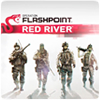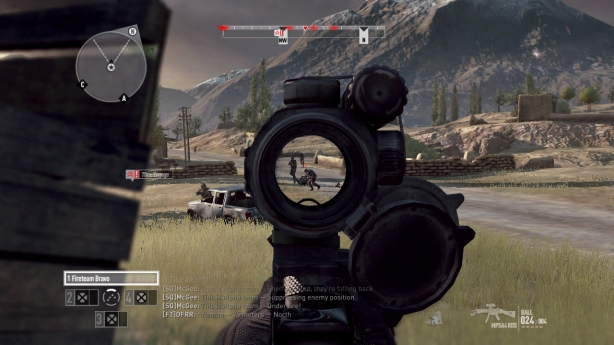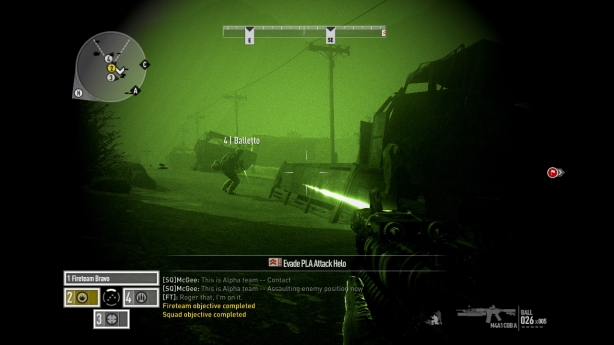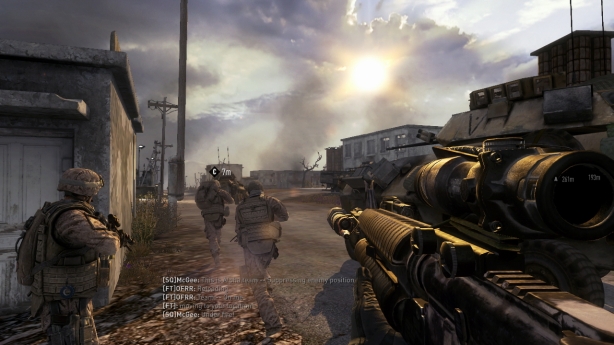Operation Flashpoint: Red River Review
 Game: Operation Flashpoint: Red River
Game: Operation Flashpoint: Red River
Developer: Codemasters
Publisher: Codemasters
Available On: Xbox 360, PlayStation 3, PC (Xbox 360 Version Reviewed)
In a gaming landscape where each new entry in the Call of Duty series instantly sells millions of copies on day one without even trying, gamers may begin to feel that the military life is packed full of bombastic set pieces where a hero is called upon to dramatically charge head-first into the breach and, against-the-odds, save the day. Fed on a diet of these games, any young child would be mistaken for thinking the army life is a fun and exciting one. Well folks, Codemasters are here to provide gamers with a reality check and drag prospective recruits kicking and screaming back into the realms of the possible.
With Operation Flashpoint Red River, the latest instalment in their military simulation series, Codemasters sacrifice some of the action-movie credentials most first-person shooters like to exploit, relacing them with a much grittier, down-to-earth experience. When the previous game in the series, Dragon Rising, was released in 2009, the title was praised for its realistic portrayal of war and the tension that was created in missions, but AI problems and a general lack of polish made the game seem unfinished and disappointing. What have the development team learned in the two years since the last release?
STORY: The game kicks off with a well put together collage style slide-show, which relates important occurrences and figures involved in the events which lead up to the game. Set in 2013, during a fictional wartime conflict taking place in Middle-Eastern country Tajikistan, the game follows a small Fireteam of four Marines. A civil war in the country erupts and in the ensuing chaos, as U.S. Military forces attempt to defuse the situation, The Democratic Republic of China suspect foul play, leading to a series of events that quickly escalate into full-blown warfare.
The story is told in a combination of two ways. Between missions, more of these slick motion comics inform the players of the current situation and what is expected of them in the upcoming encounter. In-mission, the relationships between the four squad-mates and their cohorts are explored purely through radio chatter and the incessant barking of the Staff Sergeant. Both are spoken in an authentic U.S. Marine patter, with a whole host of profanities and anti-terrorist jibes flying left, right and centre. Whilst I’m sure this accurately portrays those who take part in these combat situations, the gung-ho Jock attitude soon becomes grating and due to the fact that so much of the conversation takes place in Army speak (complete with code-names and abbreviations) it is easy for the uninitiated to quickly lose track of what on earth everyone is jabbering on about.
It must be said though, the use of radio communications and squad-based chat does immerse the player into the world very well. By cutting back on formalised conversations and cutscenes where the player must sit and listen to someone talk, the user feels much more involved in the action and drawn into the tension. Unfortunately this jars greatly with the mid-mission transport sections. Often the squads must mount up in Hummers to makes their way from point A to point B, and during these sections it is common to be stuck in place, with no interaction available, forced to listen to the Staff Sergeant to simply be admonishing the trigger-happy Marines on their over-anxious attitudes. Nothing that they say in these sections ever seems to be of any use in pushing the story onwards or developing the characters. Of course, to simply skip the transport sections would break the realistic immersion, but they tend to feel over-long and under utilised.
GRAPHICS: Being based in huge, sprawling levels that are inhabited by many rural farmhouses, fields and mountain ranges, where players are given relative freedom in the way they approach each encounter, there are bound to be some graphical sacrifices made. These massive vistas, with impressively long draw distances and the capacity for displaying many enemies and allies on-screen at once balance up against jittery animations and frankly horrible shadow effects that flicker greatly and appear very blocky. Enemies and team-mates alike will appear in bad animation cycles from time to time, where they jump around unnaturally, and when it comes to entering a vehicle, the developers just cut out the animation entirely as players will suddenly appear in the back of the vehicle without even stepping in. For a game that seems to champion immersion so heavily, it is little touches like this that detract from the experience in such a silly way.
But when you do take your squad over a mountain peak and look out over the vast plain below, with the glare of the sun shining into your eyes, you see the Dr Jekyll to the game’s Mr Hyde. To create such large play spaces, where huge firefights can break out between the warring factions, as helicopters whizz overhead and Hum-Vees skid across the road nearby, without the game performance suffering, you can see where the graphical engine is really succeeding. Whilst not only being huge, the landscapes seem to portray the kind of Middle-Eastern conflict we see on the news and in films down to a T. Vegetation and landscapes are convincing, and rarely does anything appear out-of-place or staged, these villages and outposts are truly convincing. Sometimes the lack of detail in character models and the basic blood and damage effects can be forgiven when paired up with such impressive level construction and design.
SOUND: In the same way that the content of the conversations meet our expectations, consisting as they do of the pro America chatter and damning indictments of the enemy, the delivery and voice acting doesn’t disappoint and could have been taken straight from Jarhead or the Hurt Locker. The voices all fit the characters well and are exactly what you would expect from a group of young Marines, thirsty to serve their country. Again, this is not necessarily a good thing, as it all comes across as quite immature and doesn’t endear the characters to the player. In fact, I didn’t find myself growing attached to any of the Marines involved. This is surely not down to the skills of the actors, but the scriptwriters could have taken more care in creating a group of soldiers which were more likeable and that players could relate to.
That said, sound effects are excellent throughout the game, with guns reloading and bullets being fired off sounding terribly authentic and when you find yourself in the middle of a battle, the hail of gunfire really sounds like it is whizzing around your ears, and when an insurgent yells in a foreign tongue, it succeeds tremendously in setting your nerves on edge and making the user feel like they are in danger. Music isn’t used during these battles, which might seem unusual when compared to other games in the genre, but when the drive for realism is taken into consideration, the decision not to use music is justified and it would clash with the overall aims of the game. Licensed music does appear when aboard troop transports, for example, and is the kind of adrenaline-packed rock that real life soldiers seem to play in order to psych themselves up between missions, so it is very suitable for the times when it is used.
GAMEPLAY: Gameplay is what Red River is all about. It eschews the spit and polish of your standard FPS in exchange for intense and compelling warfare that is designed to make your heart beat faster. This begins with the basic selection of three difficulty modes. Played on normal, gamers will have the advantage of a compass, radar and other HUD features such as a bleed-out meter. Move onto the higher diffculties and these disappear, until on the hardest level, there are no on-screen visuals that a soldier wouldn’t normally see (other than subtitles). This really drops you right into the shoes of a recent army recruit, as you have to quickly acclimatise to the idea of knowing which direction is North, identifying which farmhouse is a viable target and which may contain innocent civillians, and even differentiating friends from foes. Soldiers in uniform look awfully similar when in the midst of gunfire, with the afternoon sun glaring in your eyes, and this makes friendly fire a very real possibility, and acts to really test your reflexes and recognition.
This is the real strength of the title. You feel immersed into the situation and must act like a real soldier, using your different equipment to suit the mission and you must act like a soldier to survive. Run in guns blazing and you will soon die. Single shots can kill in Red River and even a leg shot will kill you given time. Whilst bodily injuries will slow you down, stop you from running or reduce your accuracy, if left untreated you will bleed out. This is where the healing system kicks in. You must heal yourself and your teammates, or request they heal you. Patch yourself up to stop the bleeding or heal yourself entirely with a field medical kit. This will take time though, and is an intentional slowing of the pace. The realism is ramped up as an injury will put you out of action for around twenty seconds as you heal, leaving you exposed to enemy gunfire and explosives all around. If you take a big hit, pray that you were hit when in a sheltered location as there is no Gears of War style crawling around into cover. If you are incapacitated, the player really can’t do anything but radio for help.
This leads us nicely onto the squad radio system. The D-pad is assigned to different commands, and when initiated, can be used to direct your team, ask them to defend positions, put down suppressing fire toward the enemy, or call for the medic to patch you up, amongst several other orders. The tactical and correct usage of all of these orders is paramount to a successful mission. Forget to keep in contact with your team and you will find yourself all alone in a bad part of town. Don’t order your team to lay down a wave of fire at the enemies, and the other squads will never stand a chance and be mown down as they storm the village. This does put a greater deal of responsibility on your shoulders, as you will feel it is your fault when your squad members go down under fire. The sense of camaraderie and dependency is strong, even in single-player modes.
In addition to the main campaign, there are a selection of challenges, entitled Fireteam Engagements. There are four different games modes, each featuring two different maps and objectives. They are; CSAR, where you must rescue downed Helicopter pilots, Last Stand, where your squad defends a fixed position, Combat Sweep, which entails wiping out all enemy forces in an area, and Rolling Thunder, which involves protecting a convoy as it crosses a particular area. These add a bit of variety to proceedings, and offer several levels of completion. You can opt to complete all objectives on offer fully, or depending on performance, players can still complete the maps when only managing to escape in one piece. XP points and medals will of course be distributed accordingly, but the flexibility does mean that players won’t fail the entire mission for simply one mistake.
MULTIPLAYER: Whilst the entire game (in both campaign modes and the Fireteam challenges) is built around co-operative multiplayer, the game surprisngly has no competitive modes at all. All multiplayer is limited to two to four player co-op play. This does change the dynamic of a tactical shooter greatly though, in both good and bad ways. Firstly, the obvious advantage to playing with real cohorts is the fact that you can each communicate with the in-game chat, and use that to co-ordinate your attacks and effectively flank enemies and cover each other’s backs. Whilst AI team-mates can be unpredictable at times, due to the limitations of artificial intelligence, real-life team-mates bring the game to life in a completely different way. They can immediately respond and react to the on-screen action and the game tends to take place at a much faster pace, with higher intensity.
Of course, this kind of multiplayer game, where teamwork is key does depend entirely on how the participants choose to play the game. There will be, unsurprisingly, some players who just won’t get the point of working as a team to tactically engage the enemy. In co-op, one squad member will be assigned as the Fireteam leader, who can then set orders and tactics. In contrast to the single-player campaign where AI bots will unthinkingly follow orders to the letter, even if it is to their detriment, co-operative play depends on other humans actually willingly following what the team leader tells them to do. Without this, the whole strategy aspect of the game begins to fall apart, and that is why, despite the game being available to play in public multiplayer, it is best experienced with a group of like-minded friends, who can work with one another amicably.
One of the biggest negatives however, is that there is sadly no split-screen couch co-op in the title. For a game which has been built from the ground up with co-operative gameplay in mind, it seems silly not to include this feature. Games such as Left 4 Dead, Gears of War, and even the Call of Duty titles have shown that couch co-op still has a more than viable place in modern gaming, with co-operative gaming experiencing quite a resurgence of late. In a game where communication and co-ordination is king, being able to play on the same console would have been a no-brainer, but unfortunately the feature is nowhere to be found, much to the detriment of the title.
LONGEVITY: The vast majority of missions in campaign, and even the Fireteam Engagements (FTE’s), will provide hour upon hour of fun if played with a mind toward meeting all objectives and gathering gold medals. In order to fully level up your characters, you will need to complete as many objectives as possible, with as few casualties as you can, so a lot of care and time will have to be invested into the game. The three different difficulty levels also add different dimensions to gameplay, which almost demand to be replayed in order to see just how real the game can get. In playing through the ten campaign missions and eight FTE ones, it is likely players will invest well in excess of twenty hours of gametime, but then in order to attain all of the achievement points and medals awarded, you could be looking at two or three times that number. Online Leaderboards are unlikely to add much replay value to the title, as the only really track basic stats such as kills, deaths and revives, but the core experience is expansive enough by itself.
VERDICT: Operation Flashpoint may lack the polish and cinematic flair that the Modern Warfare titles popularised, but it takes on more of the thinking man’s approach that PC gamers seem so partial to, and this seems to be one of the biggest problems for the Flashpoint series. It has repeatedly been labelled as a PC shooter that was somehow released on home consoles by mistake. The methodical thought-out approach to each scenario is closer to the early Rainbow Six games than to regular console first-person shooters.
However, it is not without fault. The game does display a severe lack of graphical polish, and seemingly obvious options like couch co-op are omitted, but if you have grown tired of the balls-to-the-wall rappelling through windows and running from explosions found in your average FPS, this is just the kind of reality check you have been waiting for, delivering a visceral and intense simulation experience. Operation Flashpoint is a breath of fresh air in terms of console shooters, but this Red River doesn’t always run smoothly.










